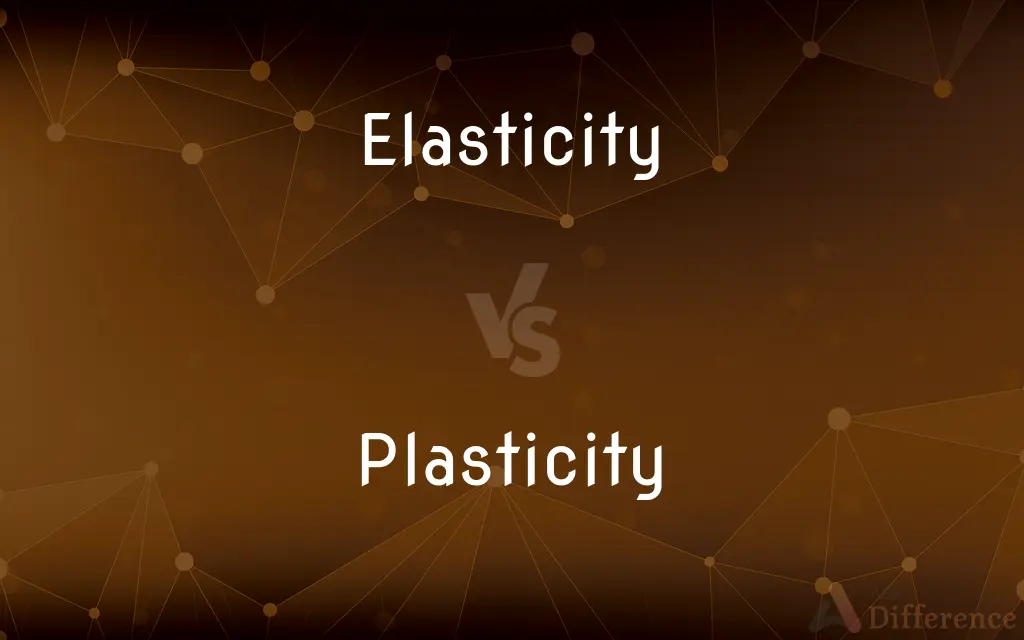Elasticity vs. Plasticity — What's the Difference?
By Urooj Arif & Fiza Rafique — Updated on May 13, 2024
Elasticity refers to a material's ability to return to its original shape after deformation when stress is removed, whereas plasticity describes the ability of a material to permanently deform without breaking under stress.

Difference Between Elasticity and Plasticity
Table of Contents
ADVERTISEMENT
Key Differences
Elasticity is characterized by a material's capacity to withstand temporary deformation and revert back to its original form once the applied stress is removed. This property is commonly observed in materials like rubber bands and springs. On the other hand, plasticity is the tendency of a material to undergo irreversible deformation where it remains permanently deformed even after the stress is no longer applied, as seen in materials like clay and metals when shaped.
While elasticity is essential in applications where recovery from deformation is crucial, such as in vehicle suspension systems, plasticity is vital in processes like metal forging and sculpting, where maintaining the new shape is desired.
Elastic materials store and release energy, which is critical in applications like bouncing balls and shock absorbers. In contrast, plastic materials absorb energy without significant rebound, important for applications requiring energy dissipation, such as in car bumpers.
Comparison Chart
Reversibility
Reversible deformation
Irreversible deformation
Energy
Stores and releases energy
Absorbs and dissipates energy
ADVERTISEMENT
Application Examples
Springs, elastic bands
Metal forging, sculpting clay
Material Behavior
Returns to original shape after stress
Stays deformed after stress is removed
Critical Point
Yield point (elastic limit)
Yield point marks onset of plastic behavior
Compare with Definitions
Elasticity
In physics, the ability of a body to resist a distorting influence and to return to its original size and shape.
Engineers test the elasticity of bridge materials to ensure they can endure changing loads.
Plasticity
The quality of being easily shaped or molded; malleability.
The plasticity of clay makes it popular in pottery and sculpture.
Elasticity
Describes materials that can recover from extensive stretching or compressing.
The elasticity of a bungee cord is crucial for safe bungee jumping.
Plasticity
Refers to the deformation of a material undergoing non-reversible changes.
The plasticity of soft metals is utilized in automotive body panels.
Elasticity
Property of a material to return to its original shape after deformation.
The elasticity of the rubber band allowed it to stretch and snap back repeatedly.
Plasticity
Applies to materials that can sustain permanent changes under external forces.
The plasticity of steel is exploited in constructing durable and resilient building structures.
Elasticity
A measure of the responsiveness of quantity demanded or supplied to changes in one of its determinants.
Price elasticity of demand indicates how quantity demanded of a good responds to a price change.
Plasticity
Capable of being shaped or formed
Plastic material such as clay.
Elasticity
Often associated with materials that exhibit temporary deformation.
The mattress demonstrated great elasticity by regaining its shape after being pressed.
Plasticity
Relating to or dealing with shaping or modeling
The plastic art of sculpture.
Elasticity
The condition or property of being elastic; flexibility.
Plasticity
Having the qualities of sculpture; well-formed
"the astonishing plastic beauty of the chorus girls" (Frank Harris).
Elasticity
The property of returning to an initial form or state following deformation.
Plasticity
Giving form or shape to a substance
The plastic forces that create and wear down a mountain range.
Elasticity
The degree to which this property is exhibited.
Plasticity
Easily influenced; impressionable
"The plastic mind of the bank clerk had been ... distorted by what he had read" (Rudyard Kipling).
Elasticity
A measure of how changes in price affect supply or demand for a given good, equal to the percentage of change in supply or demand divided by the percentage of the price change.
Plasticity
Made of a plastic or plastics
A plastic garden hose.
Elasticity
(physics) The property by virtue of which a material deformed under load can regain its original dimensions when unloaded
Plasticity
(Physics) Capable of undergoing continuous deformation without rupture or relaxation.
Elasticity
(economics) The sensitivity of changes in a quantity with respect to changes in another quantity.
If the sales of an item drop by 5% when the price increases by 10%, its price elasticity is −0.5.
Plasticity
Capable of building tissue; formative.
Elasticity
(computing) A measure of the flexibility of a data store's data model and clustering capabilities.
Plasticity
Able to change and adapt, especially by acquiring alternative pathways for sensory perception or motor skills. Used of the central nervous system.
Elasticity
(computing) A system's ability to adapt to changes in workload by automatically provisioning and de-provisioning resources.
Plasticity
Marked by artificiality or superficiality
A plastic world of fad, hype, and sensation.
Elasticity
(mathematics) The ratio of the relative change in a function's output with respect to the relative change in its input, for infinitesimal changes at a certain point.
Plasticity
(Informal) Of or obtained by means of credit cards
Plastic money.
Elasticity
The quality of being elastic.
Plasticity
Any of various organic compounds produced by polymerization, capable of being molded, extruded, cast into various shapes and films, or drawn into filaments used as textile fibers.
Elasticity
Adaptability.
Her elasticity allowed her to recover quickly.
Plasticity
(Informal) A credit card or credit cards
Would accept cash or plastic in payment.
Elasticity
The quality of being elastic; the inherent property in bodies by which they recover their former figure or dimensions, after the removal of external pressure or altering force; springiness; resilience; tendency to rebound; as, the elasticity of caoutchouc; the elasticity of the air.
Plasticity
The quality or state of being plastic.
Elasticity
Power of resistance to, or recovery from, depression or overwork; - usually referred to as resilience[3].
Plasticity
(physics) the property of a solid body whereby it undergoes a permanent change in shape or size when subjected to a stress exceeding a particular value (the yield value)
Elasticity
The tendency of a body to return to its original shape after it has been stretched or compressed;
The waistband had lost its snap
Plasticity
The quality or state of being plastic.
Plasticity
Plastic force.
Plasticity
The property of being physically malleable; the property of something that can be worked or hammered or shaped under pressure without breaking
Plasticity
In neuroscience, the ability of the brain to adapt to changes in an organism's environment.
Brain plasticity allows for learning and memory formation throughout a person's life.
Plasticity
A condition of being permanently deformed without breaking.
The plasticity of the material was evident as it did not return to its original form after the pressure was removed.
Common Curiosities
What distinguishes elasticity from plasticity in materials?
Elasticity involves temporary deformation with return to original shape, while plasticity involves permanent deformation.
What is an example of a material that primarily exhibits plastic behavior?
Metals like aluminum and copper exhibit significant plastic behavior when used in applications like wiring and plumbing.
Why is elasticity important in everyday items?
Elasticity allows items like vehicle springs and rubber bands to perform their functions reliably by absorbing and releasing energy.
Can a material exhibit both elasticity and plasticity?
Yes, many materials exhibit both properties, with elastic behavior up to a certain stress (yield point) and plastic behavior beyond it.
In what industrial processes is plasticity an advantageous property?
Plasticity is crucial in industrial processes like metal forging and thermoplastic molding, where permanent shaping is required.
How does the concept of plasticity apply to neuroscience?
In neuroscience, plasticity refers to the brain's ability to change and adapt structurally and functionally in response to learning and experience.
How do elasticity and plasticity affect material selection in product design?
Material selection often depends on whether a product must withstand repetitive stress without deforming (elasticity) or must be shaped permanently (plasticity).
What role does the yield point play in understanding material behavior?
The yield point marks the transition from elastic behavior, where deformation is reversible, to plastic behavior, where deformation becomes permanent.
How do engineers utilize the properties of elasticity and plasticity?
Engineers use elasticity for designing structures and devices that need to rebound or return to form, and plasticity for those that must be durable and maintain new shapes under stress.
What tests are used to measure the elasticity and plasticity of materials?
Tests like tensile testing for elasticity and compression testing for plasticity help determine how materials will behave under different stresses.
Share Your Discovery

Previous Comparison
Superman vs. Batman
Next Comparison
Distillate vs. ResidueAuthor Spotlight
Written by
Urooj ArifUrooj is a skilled content writer at Ask Difference, known for her exceptional ability to simplify complex topics into engaging and informative content. With a passion for research and a flair for clear, concise writing, she consistently delivers articles that resonate with our diverse audience.
Co-written by
Fiza RafiqueFiza Rafique is a skilled content writer at AskDifference.com, where she meticulously refines and enhances written pieces. Drawing from her vast editorial expertise, Fiza ensures clarity, accuracy, and precision in every article. Passionate about language, she continually seeks to elevate the quality of content for readers worldwide.













































